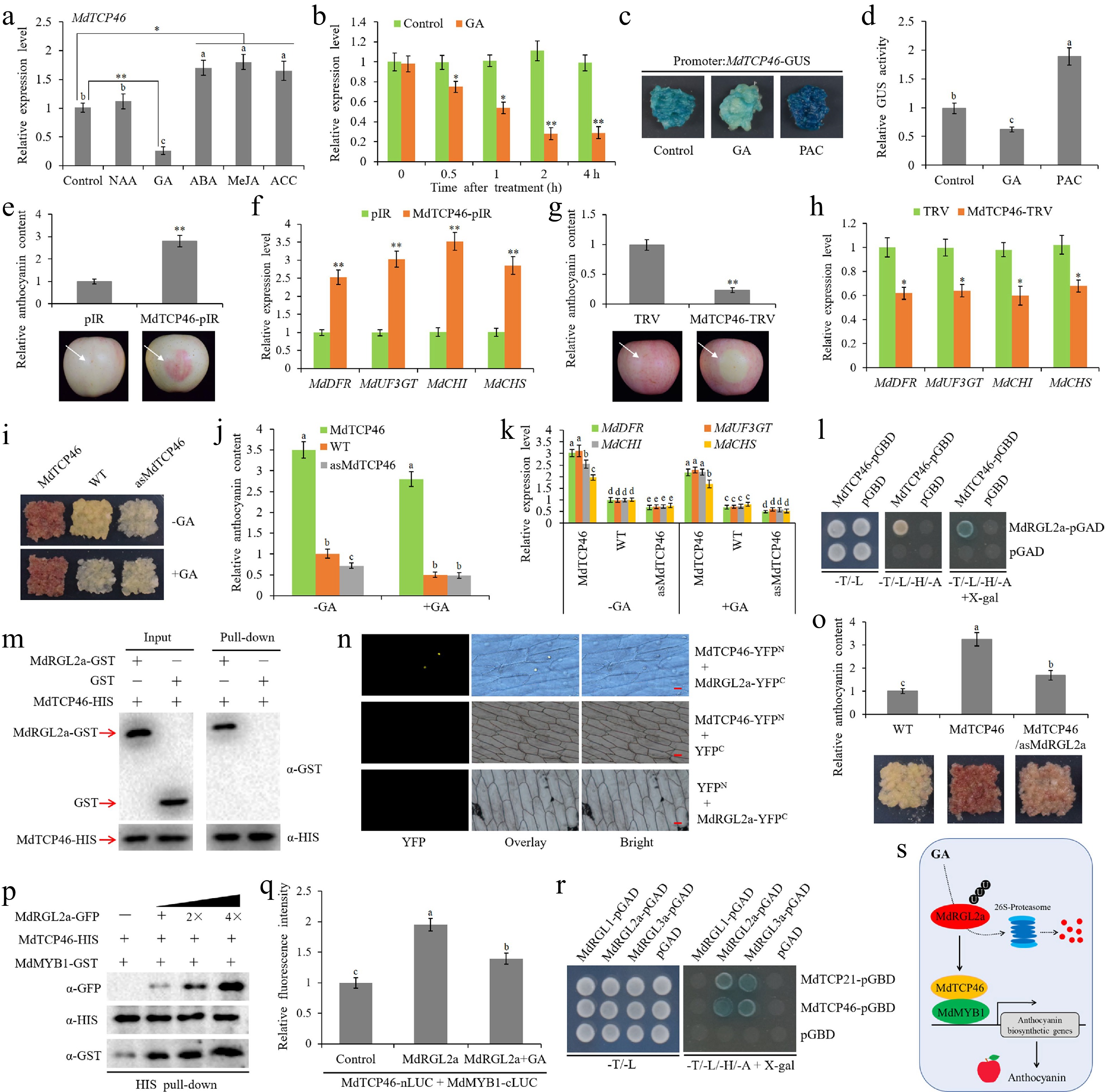-

Figure 1.
The MdRGL2a-MdTCP46-MdMYB1 module mediates anthocyanin biosynthesis in response to GA. (a) Expression of MdTCP46 after treatment with 10 μM of 1-naphthaleneacetic acid (NAA), gibberellin (GA), abscisic acid (ABA), methyl jasmonate (MeJA), l-aminocyclopropane-l-carboxylic acid (ACC) for 4 h using qRT-PCR. The value of control without any treatment was set to 1. (b) Expression of MdTCP46 in response to 10 μM of GA3 (GA) for 4 h. The value of control before treatment was set to 1. (c) Phenotypes of transgenic apple callus carrying the MdTCP46 promoter sequence fusion with the GUS tag after GUS staining for 1 h. GA, apple callus treated with 10 μM of GA; PAC, apple callus treated with 2 μM of paclobutrazol (PAC); apple callus without any treatment was used as control. (d) Determination of the GUS activity of apple callus shown in (c). The value of control was set to 1. (e), (f) Functional identification of MdTCP46 using overexpression assays in apple fruits. The anthocyanin content and anthocyanin biosynthetic gene expression around the infiltration sites were measured 3 d after infiltration. Each treatment was performed in triplicate, and each replicate comprised 8–10 apple fruits. Representative pictures are shown. The anthocyanin content and gene expression level in the sites infiltrated with empty vector were set to 1. pIR, IL60-1 + IL60-2; MdTCP46-pIR, IL60-1 + MdTCP46-IL60-2. (g), (h) Functional identification of MdTCP46 using suppression assays in apple fruits. The anthocyanin content and anthocyanin biosynthetic gene expression around the infiltration sites were measured 6 d after infiltration. Each treatment was performed in triplicate, and each replicate comprised 8–10 apple fruits. Representative pictures are shown. The anthocyanin content and gene expression level in the sites infiltrated with empty vector were set to 1. TRV, TRV1 + TRV2; MdTCP46-TRV, TRV1 + MdTCP46-TRV2. (I-K) Functional identification of MdTCP46 via stable transformation in apple callus. Fifteen-day-old apple callus were transferred to -GA or +GA (10 μM) medium and incubated under constant light at 24 °C for 5 d. Each treatment was performed in triplicate and each replicate contained 3–5 callus masses. WT, wild-type apple callus; MdTCP46, MdTCP46-overexpressing apple callus; asMdTCP46, apple callus with suppression of MdTCP46. The anthocyanin content and anthocyanin biosynthetic gene expression in WT grown on -GA medium were set to 1. (l) Y2H assays showing the interaction between MdTCP46 and MdRGL2a. (m) Pull-down assays. (n) BiFC assays. (o) Validation of synergistic effects of MdRGL2a on MdTCP46-mediated anthocyanin accumulation in apple callus. Fifteen-day-old apple callus were incubated under constant light at 24 °C for 5 d. Each treatment was performed in triplicate and each replicate contained 3–5 callus masses. WT, wild-type apple callus; MdTCP46, MdTCP46-overexpressing apple callus; MdTCP46/asMdRGL2a, overexpression of MdTCP46 and silencing of MdRGL2a. Anthocyanin content in WT was set to 1. (p) Competitive binding assay. The mixture of MdRGL2a-GFP and MdMYB1-GFP was added to immobilized MdTCP46-HIS. The gradient indicates the increasing amount of MdRGL2a-GFP. Western blot analysis was performed with anti-GFP, anti-HIS, and anti-GST antibodies. (q) Luciferase complementation imaging assay in N. benthamiana leaves. Control, co-expression of MdTCP46-nLUC/MdMYB1-cLUC and pXSN-GFP empty vector; MdRGL2a, co-expression of MdTCP46-nLUC/MdMYB1-cLUC and MdRGL2a-pXSN-GFP; MdRGL2a + GA, co-expression of MdTCP46-nLUC/MdMYB1-cLUC and MdRGL2a-pXSN-GFP along with the treatment of 10 μM GA. The fluorescence intensity of the control was set to 1. (r) Y2H assays. (s) A working model of MdTCP46 functioning in GA-mediated anthocyanin biosynthesis. Error bars denote standard deviations. Different lowercase letters indicate significant difference at p < 0.05 based on one-way ANOVA test. Asterisks indicate statistical significance based on t-test. *, p < 0.05; **, p < 0.01.
Figures
(1)
Tables
(0)